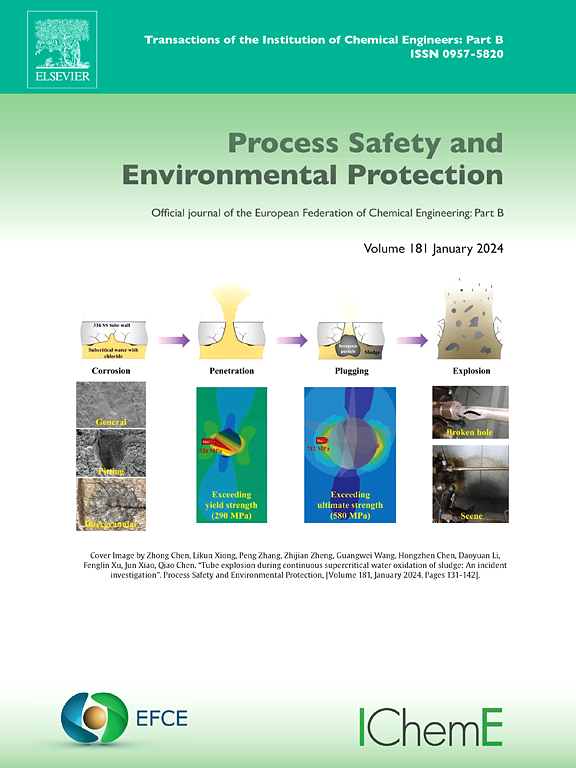The simultaneous optimization of detoxification for ferulic acid and saccharification processes using highly efficient modified lignin
IF 7.8
2区 环境科学与生态学
Q1 ENGINEERING, CHEMICAL
引用次数: 0
Abstract
A novel modified lignin adsorbent was prepared from residual lignin in alkali-pretreated rice straw. Density functional theory (DFT) calculations were used to select the optimal modification method, aiming to create an efficient adsorbent with strong affinity for ferulic acid and minimal binding to cellulase. The DFT results showed that sulfomethylated lignin had a high binding affinity of −15.655 kcal mol−1 and the shortest hydrogen bond length (1.76 Å) with ferulic acid. In contrast, it had a lower binding affinity of −11.390 kcal mol−1 and a longer Pi-Pi stacking distance (3.36 Å) with cellulase. Compared to other adsorbents, sulfomethylated lignin demonstrated a higher adsorption efficiency for ferulic acid (72.85 %). Quartz Crystal Microbalance with Dissipation Monitoring (QCM-D) curves indicated a reduction in nonproductive adsorption between modified lignin and cellulase. The adsorption of ferulic acid by modified lignin fitted the pseudo second-order model better, suggesting that the process was primarily driven by chemical interactions such as ion exchange or electrostatic attraction. Additionally, the reduction in nonproductive adsorption of cellulase was associated with changes in the electronegativity and hydrophobicity of the modified lignin. This study simultaneously reduced the ferulic acid toxicity and cellulase nonproductive adsorption, achieving dual benefits in detoxification and saccharification processes.
利用高效改性木质素同时优化阿魏酸解毒和糖化工艺
以碱预处理稻秆残木质素为原料,制备了一种新型改性木质素吸附剂。利用密度泛函理论(DFT)对改性方法进行优选,制备出对阿魏酸亲和力强、与纤维素酶结合最小的高效吸附剂。DFT结果表明,硫甲基化木质素与阿魏酸的结合亲和力为−15.655 kcal mol−1,氢键长度最短(1.76 Å)。相比之下,它与纤维素酶的结合亲和力较低,为−11.390 kcal mol−1,与纤维素酶的Pi-Pi堆积距离较长(3.36 Å)。与其他吸附剂相比,硫甲基化木质素对阿魏酸的吸附效率更高(72.85 %)。石英晶体微天平耗散监测(QCM-D)曲线表明改性木质素与纤维素酶之间的非生产性吸附减少。改性木质素对阿魏酸的吸附更符合伪二阶模型,表明该过程主要由离子交换或静电吸引等化学相互作用驱动。此外,纤维素酶非生产性吸附的减少与改性木质素的电负性和疏水性的变化有关。本研究同时降低了阿魏酸的毒性和纤维素酶的非生产性吸附,在解毒和糖化过程中实现了双重效益。
本文章由计算机程序翻译,如有差异,请以英文原文为准。
求助全文
约1分钟内获得全文
求助全文
来源期刊

Process Safety and Environmental Protection
环境科学-工程:化工
CiteScore
11.40
自引率
15.40%
发文量
929
审稿时长
8.0 months
期刊介绍:
The Process Safety and Environmental Protection (PSEP) journal is a leading international publication that focuses on the publication of high-quality, original research papers in the field of engineering, specifically those related to the safety of industrial processes and environmental protection. The journal encourages submissions that present new developments in safety and environmental aspects, particularly those that show how research findings can be applied in process engineering design and practice.
PSEP is particularly interested in research that brings fresh perspectives to established engineering principles, identifies unsolved problems, or suggests directions for future research. The journal also values contributions that push the boundaries of traditional engineering and welcomes multidisciplinary papers.
PSEP's articles are abstracted and indexed by a range of databases and services, which helps to ensure that the journal's research is accessible and recognized in the academic and professional communities. These databases include ANTE, Chemical Abstracts, Chemical Hazards in Industry, Current Contents, Elsevier Engineering Information database, Pascal Francis, Web of Science, Scopus, Engineering Information Database EnCompass LIT (Elsevier), and INSPEC. This wide coverage facilitates the dissemination of the journal's content to a global audience interested in process safety and environmental engineering.
 求助内容:
求助内容: 应助结果提醒方式:
应助结果提醒方式:


